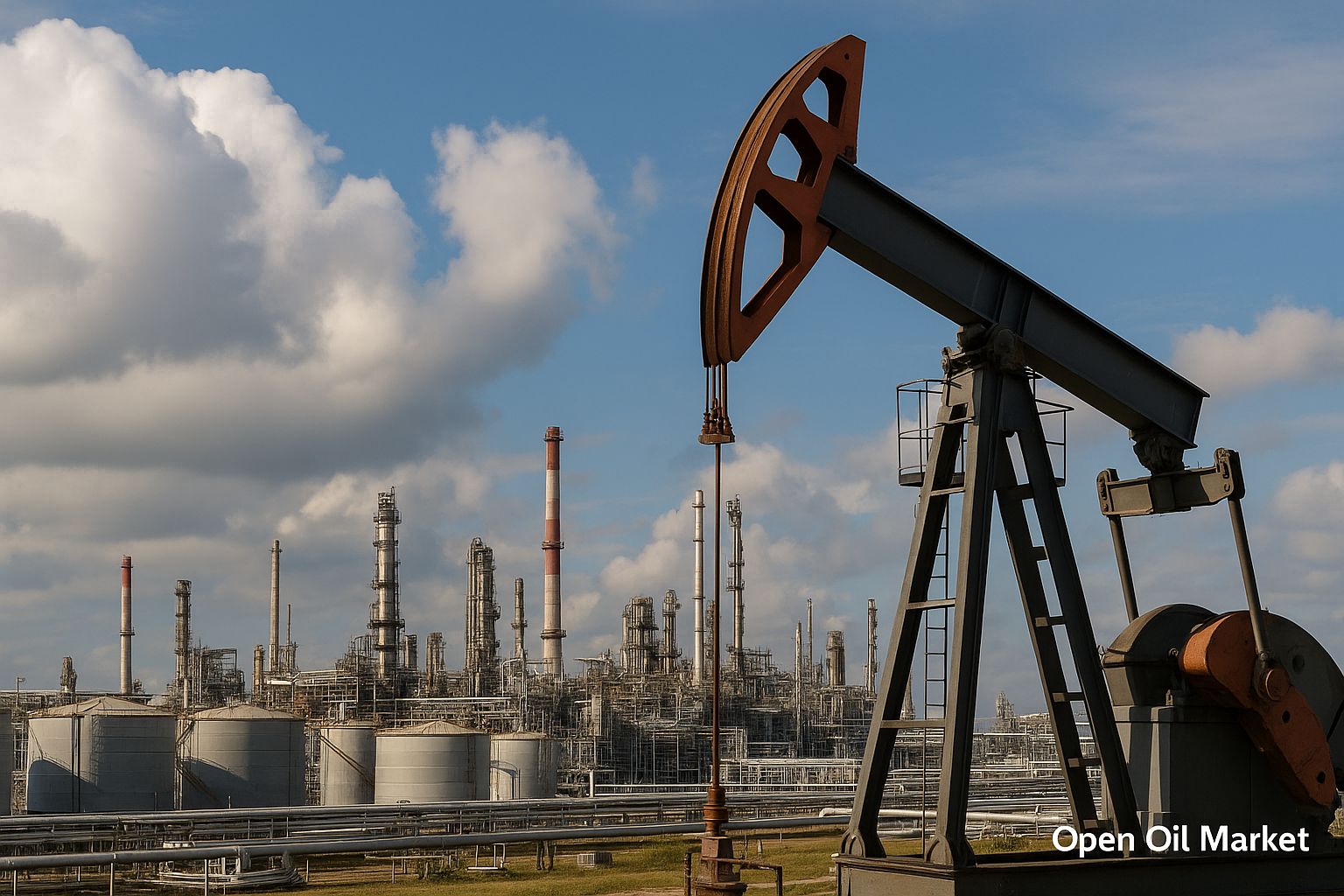Current News in the Oil, Gas, and Energy Sector for Friday, November 14, 2025. Analysis of Oil Glut, Sanctions Against Russia, European Energy Risks, and New Projects in Nuclear and Renewable Energy.
Global Oil Market: Supply Glut Pressures Prices
Global oil prices continue to be pressured by signs of oversupply and weakening demand. After a sharp decline the day before, prices stabilized on Thursday: Brent holds around $63 per barrel, while WTI hovers around $59. Investors are weighing the prospects of overproduction—recently, OPEC revised its forecast and expects global oil supply to slightly exceed demand by 2026. Similarly, the International Energy Agency (IEA) has raised its production growth forecast outside of OPEC+, signaling a potential market surplus next year. Against this backdrop, oil prices have dropped to multi-month lows.
Statistical data confirms the trend: commercial oil inventories are rising in key regions. In the U.S., crude oil stocks increased by approximately 1.3 million barrels in the week ending November 7, while a similar pattern is observable in Europe and Asia. According to analysts from Vortexa and Kpler, a record volume of oil—around 1 billion barrels—has accumulated on tankers worldwide. A significant portion of this floating supply consists of hard-to-sell oil from sanctioned countries (Russia, Iran, Venezuela), which ports refuse to accept. Additionally, the increase in exports from some major producers (e.g., Saudi Arabia) is also contributing to a temporary market oversupply. Nevertheless, experts point to a price “floor” around $60 per barrel—short-term market support is provided by supply disruption risks, particularly the anticipated tightening of U.S. sanctions against Russian exports.
Russian Oil Under Sanctions: LUKOIL Seeks Solutions, Asia Adjusts Imports
New sanctions against the Russian oil and gas sector are forcing companies and buyers to adapt. In October, the U.S. added oil companies "LUKOIL" and "Rosneft" to its sanctions list, requiring counterparties to conclude all transactions with them by November 21. Sources indicate that "LUKOIL" has approached the U.S. Treasury Department to request an extension of this deadline, as it needs more time to fulfill current contracts and sell foreign assets. Previously, the company had urgently sought to divest its international production, refining, and trading network—reports emerged of a deal with Swiss trader Gunvor; however, in early November, the U.S. Treasury expressed objections, and the deal fell through. As a result, "LUKOIL's" overseas operations are in limbo: the company was forced to declare force majeure on its largest foreign production project—the West Qurna-2 field in Iraq. "LUKOIL" is now hastily seeking new buyers for its assets and hopes to obtain a regulatory extension from the U.S. for a smooth exit from the projects.
Importers of Russian crude in Asia are also restructuring their supply chains. In India, the largest state-owned oil refiner, Indian Oil, has announced a tender for crude oil supplies in early 2024, including Russian ESPO (Eastern Siberia-Pacific Ocean) and "Sokol" crude as possible grades. However, the condition of the tender states that suppliers and loading ports must not be under U.S., EU, or UK sanctions. Thus, Indian refineries plan to continue purchasing Russian oil through alternative traders, avoiding direct cooperation with "Rosneft" and "LUKOIL." Concurrently, another Indian refining entity, Nayara Energy (partially owned by "Rosneft"), stated it will maintain significant volumes of imports from Russia despite the sanction pressure.
In China, in contrast, there is a reduction in Russian oil purchases from the largest players. Fearing secondary sanctions, several major state-owned refineries (including Sinopec and PetroChina) and independent "teapots" have nearly halved their imports of crude oil from Russia. This situation arose following the sanctions against the private Shandong Yulong refinery, which were imposed by the UK and EU for dealing with Russian crude. According to Rystad Energy, the withdrawal of Chinese companies from Russian oil has impacted about 400,000 barrels per day—up to 45% of previous supply volumes to China. As a result, Russian suppliers are forced to redirect flows to other buyers and employ more complicated sales schemes through traders in third countries.
Refining Under Attack: Russian Refineries Weather the Storm
Alongside sanctions, fuel production and refining in Russia face physical threats. In 2025, Ukraine intensified drone attacks on Russian oil infrastructure deep within its territory. Since the beginning of the year, at least 17 major refineries, oil depots, and pipelines have been affected, marking an unprecedented challenge for the industry. During the second wave of attacks (August-October), up to 20% of Russia's total refining capacity was temporarily rendered inoperable (including planned repairs). Nevertheless, Russian refiners managed to avoid a steep decline: they quickly activated backup capacities at unaffected plants and rapidly restored damaged units. According to industry reports, the total volume of oil refining in Russia from January to October decreased by only about 3% compared to the same period last year (to around 5.2 million barrels per day). The output of oil products fell by only 6%, although due to the attacks, Russian authorities were forced to temporarily restrict gasoline and diesel exports and strengthen air defense around strategic energy facilities.
Kyiv claims that drone strikes have significantly undermined Russian fuel logistics, reducing domestic gasoline supplies by dozens of percent. However, Moscow asserts that the market has stabilized: the Russian government has implemented manual price control and normalized supply, with President Vladimir Putin publicly assuring that the country "will not bend under external pressure." Experts note that in the short term, the Russian oil sector has demonstrated resilience to shocks, but further escalation of attacks or tightening sanctions could create new risks for export and production.
European Gas and Electricity: Winter Risks Amid Renewable Energy Shortages
In Europe, the peak heating season is approaching with a less comfortable gas reserve than a year ago. Gas storage facilities in the EU are not fully stocked: by early November, the average storage level was around 85% of maximum capacity, whereas typically at this time, they are close to 100%. In Germany—the largest gas consumer in Europe—storage facilities are filled to about 86%, partly due to the country's increased gas burning for electricity generation this fall. The decline in renewable energy generation (wind and hydro) has forced German energy producers to ramp up gas and coal-fired power plants. Over the first ten months of 2025, gas-generated electricity in Germany increased by approximately 15% compared to the previous year (to 41.6 TWh), and the share of gas in generation rose to 19%—the highest in the last decade. Meanwhile, total generation from wind and hydropower in the region decreased by about 7% year-on-year, and the shortfall had to be compensated by "dirtier" sources: in addition to gas, Germany increased coal generation by 4%.
The slow filling rates of storage facilities mean that Europe is entering winter with a less sturdy "safety cushion." However, experts believe that even in the case of colder weather, the region is not expected to face acute gas shortages: stocks are close to historical averages, and record volumes of liquefied natural gas (LNG) imports allow for the replacement of a significant portion of lost Russian supplies. Nevertheless, the situation in the energy market remains fragile. Continued weak winds or disruptions in LNG supplies could lead to price spikes for gas and electricity for consumers. EU authorities assure that the system is ready for winter—recently, the European Commission noted that gas levels in storage and conservation measures allow Europe to confidently navigate the upcoming heating period without implementing consumption restrictions, although much will depend on weather conditions.
Sanctions and Energy: U.S. Grants Exception to Hungary
On the geopolitical front, news has emerged regarding a temporary easing of the sanctions regime. The United States agreed to grant an exception to its EU ally—Hungary—exempting it from certain energy sanctions against Russia. U.S. Secretary of State Marco Rubio announced that for the next 12 months, restrictions will not apply to Russian oil and gas shipments to Hungary via pipelines. Effectively, Budapest has received a year-long reprieve, allowing it to continue importing energy resources from Russia, despite the general Western sanctions regime.
Additionally, the U.S. has indefinitely exempted the project to expand Hungary's Paks II nuclear power plant, which is being implemented with the participation of Russia's Rosatom. Officially, Washington explains these steps as a means to assist Hungary in ensuring energy security and diversification. The decision follows discussions between Prime Minister Viktor Orban and U.S. President Donald Trump. Previously, Orban publicly stated that he had secured a complete exemption for Hungary from sanctions on the import of Russian fuel, although it is clarified that the easing is temporary and pertains only to one year. European partners within the EU have received this U.S. maneuver with caution, given Hungary's status as the most dependent member of the bloc on Russian energy carriers.
Nuclear Energy: UK Chooses Site for First SMR
In the United Kingdom, an important step in nuclear generation development has been announced. Prime Minister Keir Starmer confirmed this week that the government has selected a site for the construction of the country's first small modular nuclear reactor (SMR). The site will be Wilfa on the Isle of Anglesey in North Wales, where a large nuclear power plant was previously decommissioned. The project will be implemented using British technology from Rolls-Royce SMR and aims to enhance energy security and achieve climate goals. It is expected that the compact reactor in Wales could supply electricity to up to 3 million homes, and its construction will create around 3,000 jobs. According to plans, the first electricity from the new facility will enter the grid in the early 2030s.
However, the British government's choice has sparked diplomatic tension. The U.S. actively lobbied for an alternative project—a large traditional nuclear power plant from Westinghouse on the same site—and sharply criticized London’s decision. The American ambassador called the reliance on SMR "disappointing," asserting that small reactors will not provide quick relief from high electricity prices in Britain and will postpone the launch of new capacities. The ambassador's statement contained unusually strong language directed at an ally. Officials in London countered that the choice of location and technology for the nuclear plant is a sovereign right of the United Kingdom. The government emphasized that it is not abandoning its partnership with the U.S. in the nuclear field—concurrently, another site for a potential large nuclear power plant is being sought where American designs could be utilized. Experts note that the contradictions surrounding the project in Wales reflect Britain's desire to develop its own innovations in energy, balancing national interests with allied relationships.
New Projects: Gas Field in Suriname Prepared for Development
A new promising source of gas has emerged in the global raw materials market. The state company Staatsolie from Suriname announced the recognition of the commercial viability of a large gas discovery in the offshore Block 52. This pertains to the Sloanea field, opened by Malaysian company Petronas, the operator of the block. Petronas holds 80% of the project, while the remaining 20% belongs to Staatsolie's subsidiary. A contract for exploration and production was signed back in 2013, and currently, three wells have been drilled with positive results, confirming significant gas reserves.
The consortium is now moving to the development phase. According to Staatsolie's statement, the development concept for Sloanea includes drilling underwater gas wells, establishing underwater infrastructure, and deploying a floating LNG plant (FLNG) right at the extraction site. It is expected that Petronas will submit a detailed development plan for regulatory approval. If everything goes well, an investment decision could be made in the second half of 2026, with Suriname expecting to start receiving its first volumes of gas in 2030. The realization of this project could transform the small country into a new liquefied gas exporter and attract foreign investments into the region's energy sector.
Renewable Energy: Generation Records and Emission Challenges
The renewable energy segment continues to experience steady growth, although climate indicators have yet to improve. According to new data from analytical centers, global electricity generation from solar power plants increased by 31% over the first nine months of 2025 compared to the same period in 2024. Wind energy is also demonstrating significant increases. Consequently, the total capacity addition for renewables in 2025 is expected to grow by around 10-11%—setting a new record for the expansion of renewable generation. The increase in clean energy is already covering almost all of the additional demand for electricity: according to the International Energy Agency (IEA), the rise in wind and solar production this year will offset most of the growth in global energy consumption.
Nonetheless, historical maximum emissions of greenhouse gases are also being updated. The international research initiative Global Carbon Project published a forecast that CO2 emissions from fossil fuel use will rise by another 1.1% in 2025, reaching a new record of approximately 38.1 billion tons of CO2. This indicates that even record rates of renewable energy adoption are currently insufficient for reducing the carbon footprint of the global economy. Experts urge countries to double their efforts in transitioning to low-carbon technologies. According to IEA analysts, the rapid growth of cheap "green" electricity makes a global energy transition almost inevitable; however, achieving climate goals by 2030 will require more decisive political measures and investments.




